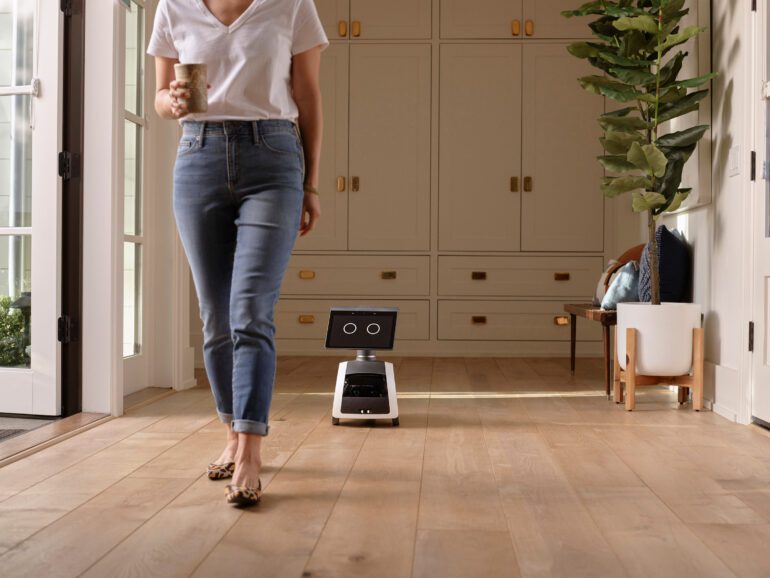TL;DR:
- Amazon introduces a “smart and conversational voice interface” to its home-monitoring robot, Astro.
- Burnham uses advanced AI techniques to make robots more intelligent, useful, and conversational.
- Burnham’s capabilities include remembering and understanding what it sees and interacting with users using language models.
- Burnham can detect emergencies, help check on elderly persons, locate lost keys, and monitor household activities.
- Burnham represents the next stage of growth for Astro, which has so far failed to meet Amazon’s expectations.
- Amazon is investing more in AI and LLM technologies.
- Burnham may test the limits of large language models as Amazon moves its AI technology into real-life physical environments.
- Burnham’s friendly personality, social awareness, and conversational skills make it a welcome addition to any family.
- The Astro unit, which developed Burnham, has faced significant cost pressures over the past year, but Amazon remains optimistic about the project’s future.
Main AI News:
Amazon’s latest project, code-named “Burnham,” introduces a “smart and conversational voice interface” to its home-monitoring robot, Astro. This new technology, called contextual understanding, uses advanced artificial intelligence techniques to make robots more intelligent, useful, and conversational.
According to documents related to Burnham, the Astro product will cost $995, with additional monitoring features available at a monthly cost of $24.99. A Burnham Plus with an Amazon Ring doorbell camera will cost $34.99 per month.
Burnham’s capabilities are quite impressive, as it can remember and understand what it sees and interact with users using language models similar to apps like ChatGPT. It can detect emergencies, such as a fire or a tap left running, and alert the owner appropriately. Additionally, it can help check on an elderly person who may have slipped and fallen in the kitchen and automatically call for help if necessary.
Owners can also ask Burnham to locate lost keys, check if the kitchen window was left open, and monitor if children have friends over after school. Essentially, Burnham can understand trivial things that happen in the home like a human being without having to worry about everything because it has implicit “common sense” knowledge.
This project represents the next stage of growth for Astro, which has so far failed to meet Amazon’s expectations despite years of investment and hundreds of people working on it. Amazon is integrating generative artificial intelligence and language model techniques into its existing products and services, just like Microsoft and Google are doing in the AI chatbot market. Amazon is even planning to upgrade its Alexa voice technology with ChatGPT-like features and create artificial intelligence tools for advertisers.
Amazon’s CFO, Brian Olsavsky, said that more investment is shifting toward AI and LLM technologies. An Amazon spokesman stated that Astro “is off to a promising start,” with strong demand for invitations. The spokesman also expressed excitement about using AI technologies to create new experiences for Astro, making customers’ lives easier and more delightful in the future.
Amazon’s development of Burnham was driven by a large research paper on language models. As these models grow in size, they can demonstrate new skills in reasoning and problem-solving. Inference, where AI models make predictions based on new data, is an essential component of Burnham’s technology. With LLMs, household robots can now handle more complex tasks, such as detecting broken glass and knowing the potential dangers.
Amazon conducted a concept demonstration to test Burnham’s reasoning and problem-solving abilities, which proved to be successful. Burnham’s technology is versatile and not limited to a single product. Amazon defined it as a set of core technologies, and it is expected to appear in a range of future robots.
This project may test the limits of large language models as Amazon moves its AI technology from the digital realm into real-life physical environments, such as home hubs. Burnham’s friendly personality, social awareness, and conversational skills make it highly available and a welcome addition to any family. The Astro unit, which developed Burnham, has faced significant cost pressures over the past year, but Amazon remains optimistic about the project’s future.
Conlcusion:
Amazon’s development of Burnham represents a significant leap forward for the home monitoring and AI markets. With Burnham’s advanced AI capabilities and conversational voice interface, Amazon is poised to revolutionize the way households interact with their home monitoring devices.
The integration of LLMs and generative AI techniques into existing products and services is an ongoing trend in the AI chatbot market, and Amazon’s move to upgrade its Alexa voice technology with ChatGPT-like features and create AI tools for advertisers will likely fuel further innovation and growth in the market. As AI technology continues to advance, we can expect to see more sophisticated and intuitive products like Burnham enter the market, offering consumers greater convenience, safety, and peace of mind.

